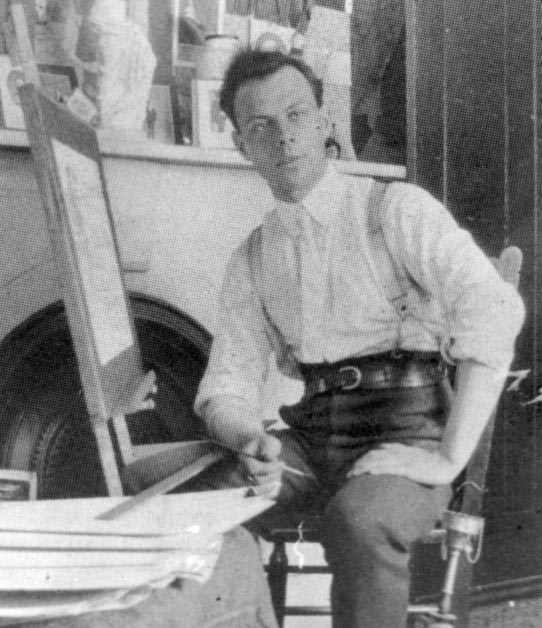
David Brown Milne, born in 1882 near Paisley, Bruce County, Ontario, was one of Canada's most distinctive and dedicated artists. Milne’s early life was marked by a humble upbringing in a frugal household, where his family lived off the produce of a small market garden and a home laundry. As the youngest of six children, Milne was often left to his own devices, which likely contributed to his early and intense interest in drawing, an activity he pursued with great enthusiasm even before entering kindergarten.
Early Struggles and Artistic Beginnings
After graduating from high school in Paisley, Milne initially worked as a country schoolteacher. However, his passion for art never waned, and he eventually made the bold decision to study painting in New York City. With financial support from his brother Jim and some of his own savings, Milne enrolled in an art school in 1903, only to see it close shortly afterward. Undeterred, he joined the Art Students’ League, where he studied under notable instructors such as George Bridgman and Frank V. Dumond.
Milne's time in New York was marked by financial hardship. To make ends meet, he turned to commercial art, taking on jobs such as sign painting, showcards, and window dressing. Despite the meager earnings and arduous conditions, these experiences enriched Milne’s artistic journey. He and fellow artist Amos Engle shared a loft over a Greek restaurant, where they lived a materially poor but intellectually vibrant life, attending exhibitions by renowned artists like Rodin, Matisse, and the French Impressionists.
Artistic Development and Early Recognition
Milne was particularly influenced by Maurice Prendergast and the French Impressionists Monet and Seurat. His early work featured patches of paint applied in a mosaic or quilt-like fashion, a technique he continued to refine over the next decade. His paintings began to gain recognition, and in 1913, five of Milne's works were selected for the groundbreaking Armory Show in New York City. This exhibition, which introduced modern art to the American public, included works by European masters like Matisse, Picasso, and Cézanne, alongside contemporary American artists.
Life as a War Artist
In 1918, amidst the turmoil of the First World War, Milne returned to Canada and enlisted in the Canadian Army. After training in North Wales, he became aware of a program employing artists to document the war. Milne was selected as a war artist and spent time in France and Belgium, creating a series of paintings that depicted the aftermath of war with a focus on devastated landscapes and military camps. These works, characterized by their elegant and understated style, offered a personal vision of the war’s consequences rather than its horrors.
Post-War Life and Continued Struggles
After the war, Milne returned to Boston Corners, New York, where he continued to paint, but financial difficulties persisted. He and his wife Patsy faced significant economic challenges, and at times, Patsy had to work in New York City while Milne remained in their rural home. Despite these hardships, Milne’s dedication to his art never wavered.
In 1924, Milne held a solo exhibition at the Art Association of Montreal, though it failed to produce any sales at a time when they desperately needed income. The couple eventually returned to the United States, where they attempted various ventures, including running a tearoom and a ski canteen, none of which were financially successful.

Later Years and Legacy
The Great Depression of 1929 further exacerbated Milne's financial woes, but his perseverance led to new opportunities. Vincent Massey, a significant patron of Canadian art, purchased many of Milne's works from his Canadian period (1929-1934) and organized a solo exhibition for him. This show, held at Mellors Gallery in Toronto, helped Milne gain new patrons and provided some financial stability.
Milne’s later years were marked by a deepening focus on his artistic practice. He moved to Six Mile Lake, near Georgian Bay, where he lived a solitary life, immersing himself in painting. His work from this period includes a series of illustrations for Bible stories, treated with a humorous and fantastical approach. These paintings, along with many others from his career, were eventually acquired by major public galleries in Canada.
Conclusion
David Brown Milne's life was one of relentless dedication to his art. Despite the financial and personal hardships he faced, Milne remained committed to his vision, producing a body of work that is now celebrated for its originality and emotional depth. His legacy as one of Canada’s most important artists continues to inspire and influence the art world today.
Browse our collection of Canadian paintings for sale at the Canadian Classic Fine Art gallery, The best place to buy a painting online. We provide free shipping anywhere in Canada and the United States. Our Montreal art gallery sells paintings online exclusively and have a 14 days return policy.
